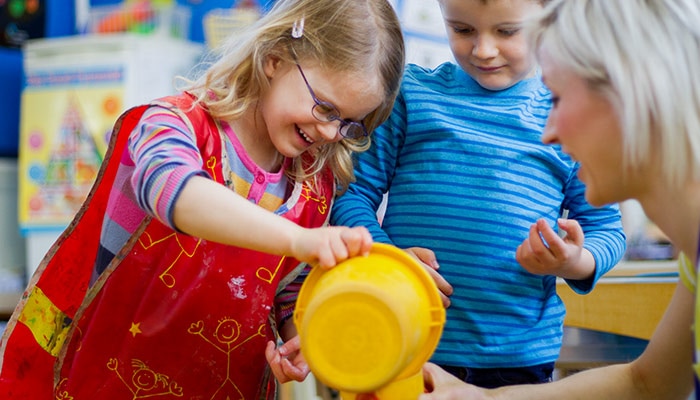While we believe that the books and resources recommended may be of value to you, keep in mind that these are suggestions only and you must do your own due diligence to determine whether the materials are appropriate and suitable for your use. PNC has no sponsorship or endorsement agreement with the authors or publishers of the materials listed.
TINKERING & MAKING

Pegboard Water Factory
Children will experiment with water flow.

Lesson Objective
Children will tinker with materials to explore water flow.
Science
What You'll Need
- 2' × 4' sheets of pegboard (available inexpensively from hardware and home stores)
- Tubing – clear vinyl or PVC (available inexpensively from hardware and home stores)
- Funnels – different sizes
- 9 oz. plastic cups with different sized holes drilled in different places, such as the bottom or sides
- Bendable wire
- Zip ties (available inexpensively at hardware and home stores)
- Water table or small wading pool
What To Do
- Fasten the pegboard to the wall, or brace it with a tub of water at the bottom.
- Connect the tubing and funnels to the pegboard using zip ties or bendable wire.
- Have the children take turns pouring water into the tops of the funnels and the tubing; watch the water flow downward.
- Make cup holders out of the wire by making a loop and sticking the ends of the wires through two holes in the pegboard. Twist the wire ends together behind the pegboard to secure.
- Have the children experiment with moving the tubes and making different arrangements on the pegboard to create water flow.
- Ask the children what they could do to make the water flow from one tube into another before the water flows to the bottom.
- Help the children with rearranging the materials to do this.
- Ask the children what they could do with the tubes to get all of the water to flow into the same cup at the bottom.
- Assist the children with rearranging the materials to accomplish this.
- Discuss how making small changes to the tubes affects the water flow.
- Discuss the fact that the water always flows downward.
Resources
High School Resources
Home educators: use these printable lesson PDFs to teach this lesson to your home schoolers. They're available in English and Spanish.
Content Provided By
Common Core State Standards Initiative – These lessons are aligned with the Common Core State Standards ("CCSS"). The CCSS provide a consistent, clear understanding of the concepts and skills children are expected to learn and guide teachers to provide their students with opportunities to gain these important skills and foundational knowledge [1]. Visit the CCSS


